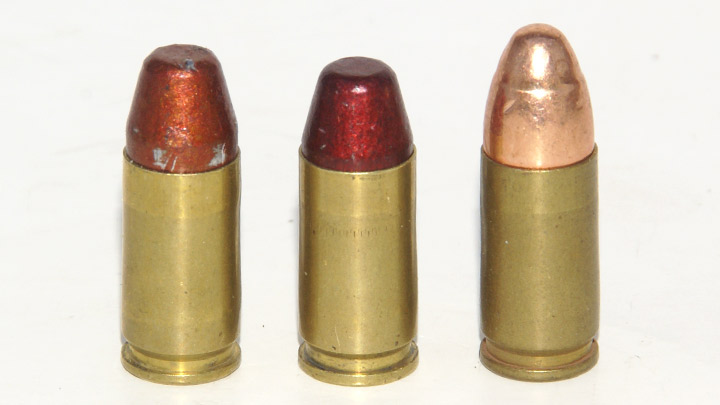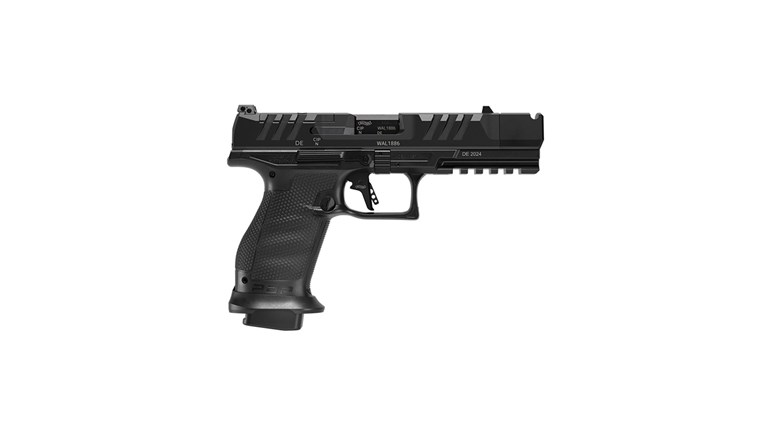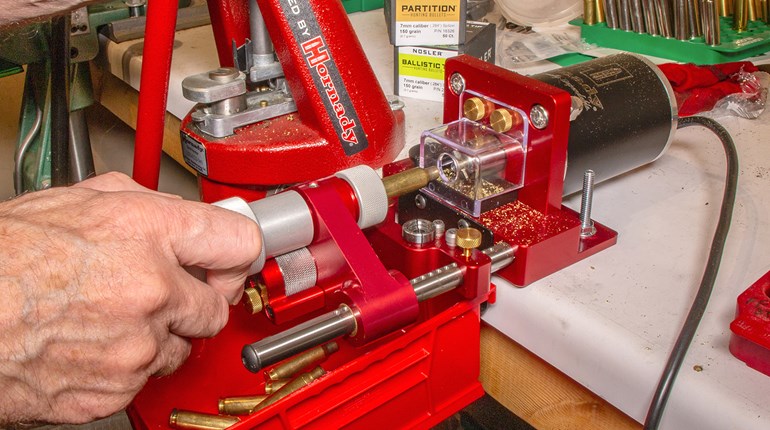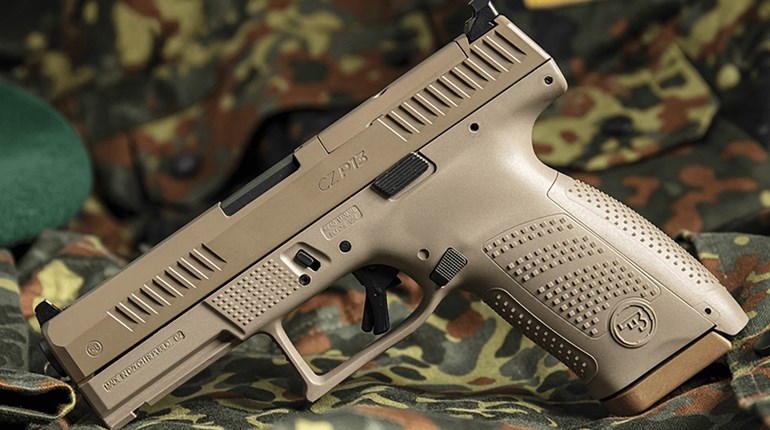
The 9mm Luger (9x19mm) is the most popular centerfire handgun cartridge in the world. Widely used by military and law enforcement agencies across the globe, it’s also the most popular choice among action shooters in both handgun and PCC competition.
High-volume shooters have learned that the 9mm Luger is simple to load, and very economical. It’s not hard to load the 9mm for $7 to $8 for a box of 50. And, buying components in bulk can trim that cost. Over time, that will easily repay for the cost of the loading equipment, and those running 10,000 to 20,000 rounds a year find it happens quickly.

The reloading process is straightforward. A three-die set (like the RCBS) will re-size and de-prime with one die, bell with the next, and seat the bullet and taper crimp it with the third. Nothing fancy. Some maker’s dies require a separate taper crimp die.
Brass is easy to come by. New brass is available from companies like Starline. The 9mm’s popularity among U.S. law enforcement agencies also sees a large supply of once-fired brass from a number of vendors. Another option is picking up range brass, and given the popularity of the 9mm there is normally a fair amount laying around at many clubs. But there are caveats.
I won’t pick up brass on any range where I know 9mm Major is commonly fired. Those pressure levels give the case a short lifespan, and it’s not worth the bother. Military brass is another issue. It uses a crimped-in primer, and there are a lot of surplus military loads on the market. They will de-prime and re-size normally, but if the primer pocket crimp is not removed the new primer will not properly seat. That brings the reloading process to a screeching halt while the shell holder is removed and the crushed primer knocked out.

Removing the crimp is a simple one-time process. I use a RCBS Trim Mate crimp remover that inserts on a hand tool and reams the primer pocket. Once that is done the case is ready for continuous use. The key is identifying military brass. And the headstamp is the identifier.
Commercial cases always have the caliber “9mm Luger,” along with the manufacturer’s identifier (FC for Federal, Win for Winchester, RP for Remington, etc.) on the headstamp. Military cases do not normally have the caliber noted. Nor will they have the usual manufacturer’s ID. These headstamps may have a two- or three-letter symbol, or number, a couple of digits indicating the year of manufacture and some bars or other odd symbols. These cases will reload normally once the crimp is removed. It pays to check headstamps on range brass, and if it looks odd, check the primer pocket. That can save a lot of annoyance and wasted reloading time later.

With the cases properly prepped, priming is the next step. Unlike the .38 Spl., there are no issues with semi-automatic handguns. Whether striker-fired or hammer-fired there is enough force to light off virtually any primer. Those shooting 9mm from a DA revolver with a match trigger in the seven to eight-pound DA pull range will need to emulate .38 Spl. loads, by using the most sensitive primers (Federal) and “crush fit” seat them to 0.006-0.008 below flush with the cartridge base.
Selecting the bullet weight and load is next. Reloading component bullets are commonly available in weights of 90, 100, 115, 120, 124, 125, 135, 147 and 160 grains. These bullets are available (in some weights) in lead, plated or jacketed versions. Lead bullets have an advantage in that they are often less expensive, and produce lower bore resistance which requires smaller powder charges (and thus less recoil) to achieve the same velocity as plated or jacketed. Their drawback is that swaged bullets are soft lead and should not be driven over 1,000 fps or leading can occur. Hard cast bullets don’t lead at 130 PF, but the waxy lubricant will create smoke. On a hot, humid and windless day that can be extremely distracting. The cast Hi-Tek coated lead bullets (like the Bayou Bullets I use) remove the drawbacks and keep the advantages of lead.

When using lead bullets make certain the case is sufficiently belled to prevent shaving lead when the bullet is seated. Shaved lead can interfere with chambering and contributes to barrel leading.
Recoil and accuracy are obvious considerations, but the most important is making the required Power Factor. In USPSA, a 125 Minor PF is required for pistol and PCC. IDPA requires a PF of 125 for pistol and 135 for PCC. Savvy shooters load 5 PF above requirements for a safety margin to account for temperature and chronograph variances. Steel Challenge has no PF requirement. All the load has to do is exit the barrel and leave a mark on the steel.
USPSA allows 9mm in Open division to be loaded to a Major PF of 165. I won’t discuss that here because there is no published/pressure tested reloading data available. It requires guns specifically built to handle the pressure far above SAAMI established levels for even +P+. It should never be shot in a standard 9mm handgun.
Making a Minor 130 PF is nothing more than bullet weight and velocity. Making it with a 90-grain bullet requires 1,450 fps and the 100-grain needs 1,300. Published pressure tested data to accomplish that is virtually impossible to find. It is beyond SAAMI established pressure levels. However, many Steel Challenge competitors (with no PF requirement) find that these two bullet weights loaded to the 1,000 to 1,100 fps range make excellent loads with little more recoil than a .22 LR.
Of the more commonly used bullet weights, the 115-grain requires 1,125 fps. The 120 needs 1,075 and the 124/125 requires 1,045 fps. They produce a snappy recoil, which some shooters find helps them get back on target quickly. Other shooters prefer the softer pushrecoil of the heavier bullets. The 135 requires 970 fps, the 147 needs 880 and the 160 needs only 810.

When loading for the PCC it’s even easier. A load fired from a five-inch pistol barrel will gain 150 to 200 fps when fired from a 16-inch PCC barrel. You can make the PF from a PCC with a load that is too light to make it from a handgun.
One last consideration is the Overall Cartridge Length (OAL). Most load data will include a recommended OAL. It usually works well with round-nose bullets because there is no bore diameter bullet protruding beyond the case mouth. Truncated cone bullets (flat points and some JHPs) can have bore diameter beyond the case mouth. This can engage the rifling and prevent the load from chambering in some chambers. These bullets may need to be seated a bit shorter than the normal OAL.

Load data is readily available from every powder manufacturer, for virtually all the above bullet weights, and the list of effective powders is far too long to list. But, the 9mm is a simple and economical cartridge to reload.
See more:
- Hornady .38 Super Comp Brass
- Vihtavuori Pistol Powders: Accurate and Clean Burning
- Take the Steel Challenge
- Understanding USPSA Comstock and Virginia Count
- Range Review: SIG P226 Legion
- New Springfield Armory XD-M Elite Precision 9mm
- Springfield Armory Hellcat: Defensive Pistol with a Defensive Pistol



































